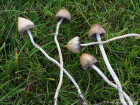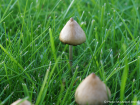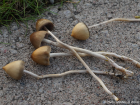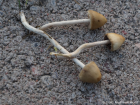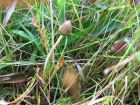Cap hygrophanous, meaning it changes colour based on moisture. When moist, it ranges from ochraceous to dark chestnut brown, often with a greenish-blue tinge. Radial lines are visible when moist. When dry, it turns pale yellow-brown. It varies in shape from sharply conical to bell-shaped, often with a prominent papilla. It does not change shape considerably as it ages. The cap margin is initially rolled inward but unrolls to become straight or even curled upwards in maturity. Gills moderately crowded together, and they have a narrowly adnexed to almost free attachment to the stem. They are olive-grey, to begin with, but turn purple-black as the spores mature. Stem slender, yellowish-brown and usually slightly thicker towards the base. The mushroom has a thin cobweb-like partial veil that does not last long before disappearing. Sometimes, the partial veil leaves an annular zone on the stipe that may be darkened by spores. Spore print very dark purple-brown.
Microscopic Features: The spores are ellipsoidal in shape and have a smooth surface. They measure 11.5-14.5 9μm in length and 7-9 9μm in width.
Psilocybe semilanceata on the www.first-nature.com web site.
Many mushrooms are poisonous, and some can be lethally toxic. Distinguishing between edible and poisonous mushrooms can be very challenging. Therefore, we strongly advise against consuming wild mushrooms. This website does not contain any information about the edibility or toxicity of mushrooms.
Although efforts have been made to ensure accuracy on this website, the information may contain errors and omissions. Therefore, all content provided is for educational and informational purposes only and should not be relied upon or used as a basis for consuming any plants or mushrooms.
External links are provided for reference only. We do not endorse or take responsibility for the content, advice, or products found on these sites or in any advertisements shown on this website.
